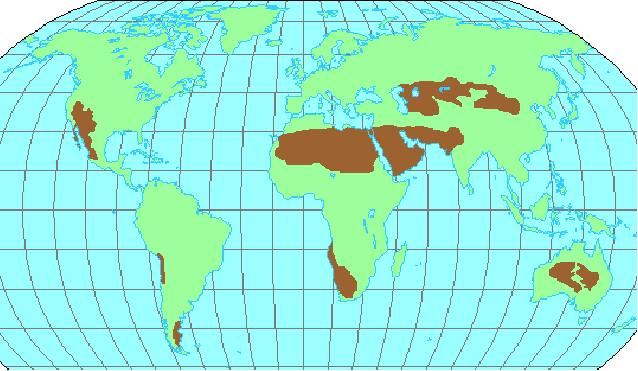Deserts
Introduction: Desert areas are rarely devoid of
life. Instead,
they abound with wonderfully adapted plants and animals that have
evolved various mechanisms for tolerating or avoiding the extremes of
aridity(dryness) and temperature that might be encountered in their
environment.
Deserts develop under four distinct geographic conditions:
- Under zones of high atmospheric pressure associated with
the
subtropics and centered near 30° latitude. Air descending from
the
upper atmosphere at these latitudes causes evaporation to exceed
precipitation. Much of the Sahara and the Australian desert can be
associated with this phenomenon.
- West coasts of continents between 20° and
30° latitude. In
these latitudes, prevailing winds are easterly and prevent moist air
from coming onto the west coast. Cold ocean currents also occur in
these locations and moisture in the sea air condenses as fog along the
shore. Some of the world's driest deserts are located right on the
coast; they received most of their limited precipitation from fog. Such
fog deserts include Baja California in North America, the western
Sahara in northern Africa; the Atacama in South America, and the Namib
in southern Africa.
- Rainshadows of high mountain ranges. When air masses are
forced over mountains and downslope, they warm and their capacity for
holding water vapor increases. Evaporation exceeds precipitation and an
arid environment or rainshadow is created on the leeward side. Such
conditions account for some of the North
American deserts (exemplified in Death Valley, CA), the
Patagonian desert in Argentina; and the Peruvian desert.
- Interiors of continents. Usually in combination with the
rainshadow
effect, distance from a major source of moist air results in dry
climates in the interior of a land mass. The Great Basin desert of the
US, the Australian desert, and the Gobi desert of Mongolia can all be
explained in large part to their interior positions.
Climate. Arid climates are those which
average
less than 10 inches of precipitation a year. Potential evaporation
exceeds precipitation in the annual water budget. Furthermore, rainfall
is highly localized and relatively unpredictable in terms of when it
will occur, although usually there are seasons of highest probability
for precipitation. Annual variation in total precipitation may also be
great. Temperatures are also variable. They may exceed 100° F
on summer
afternoons, but dip by 20-30 degrees or more at night. Winters are cool
to cold: "hot deserts" rarely experience frost; "cold deserts" may have
prolonged periods of below freezing temperatures and snowfall.
Vegetation. Shrubs are the dominant
growthform of deserts. They
may be evergreen or deciduous; typically have small leaves; and
frequently have spines or thorns and/or aromatic oils. Shallow but
extensive root systems procure rainwater from well beyond the canopy of
the shrub whenever it does rain.
Water is not entirely lacking in the desert environment and
several other growthforms represent strategies to reach water or to
store water
- Plants with long taproots that
may extend downward 20 to 30 feet to tap ground water supplies.
Especially along intermittent streams or under dunes, underground water
may be readily available. Mesquite is a good example here in North
America.
- Succulents store water accumulated
during rains for
use during the intervening dry spells. Different species store water in
different parts of the plant; hence we can recognize stem succulents,
leaf succulents, root succulents, and fruit
succulents. Most succulents do
not tolerate freezing temperatures so they are essentially limited to
the hot deserts.
Soils. There is poor development of soil,
with accumulation of calcium carbonate at or near the surface. Sparse
vegetative cover and tiny leaves results in little humus and soils
typically have a light gray color.
Animals. Like the plants, the animals of
the desert have evolved an array of strategies for dealing with
aridity.
- Behavioral adaptations such as being
nocturnal or staying the shade during the heat of day are common.
- Body Shape adaptations include those to
radiate body heat to the
environment from warm-blooded animals, body sizes are small and
appendages long. Skin coverings and feathers are light colored to
reflect
sunlight and help prevent the absorption of heat form the environment.
- Rarer, but important, are physiological
adaptations
such as aestivation (dormancy during summer), the absence of sweat
glands, the concentration of urine, localized deposits of fat in tails
or humps; and salt glands to secrete salt without losing fluids.
Reptiles with their waterproof skin, production of uric acid instead of
urine, hard-shelled eggs, and ability to gain body heat directly from
the sun and to retreat to shade or underground to avoid heat are
exceptionally well adapted to drylands and, not surprisingly, diverse
there.
Many birds in the North American deserts, so fragmented by
mountains offering humid habitats and permanent streams, simply fly to
free water and so are not limited by the lack of open water. They
maintain breeding seasons like other temperate zone birds synchronized
by changing photoperiods.
In Australia, where the desert geography is quite different and aridity
more pervasive, bird populations synchronize their breeding readiness
according to cues of rainfall, however erratic and sporadic that may
be.



